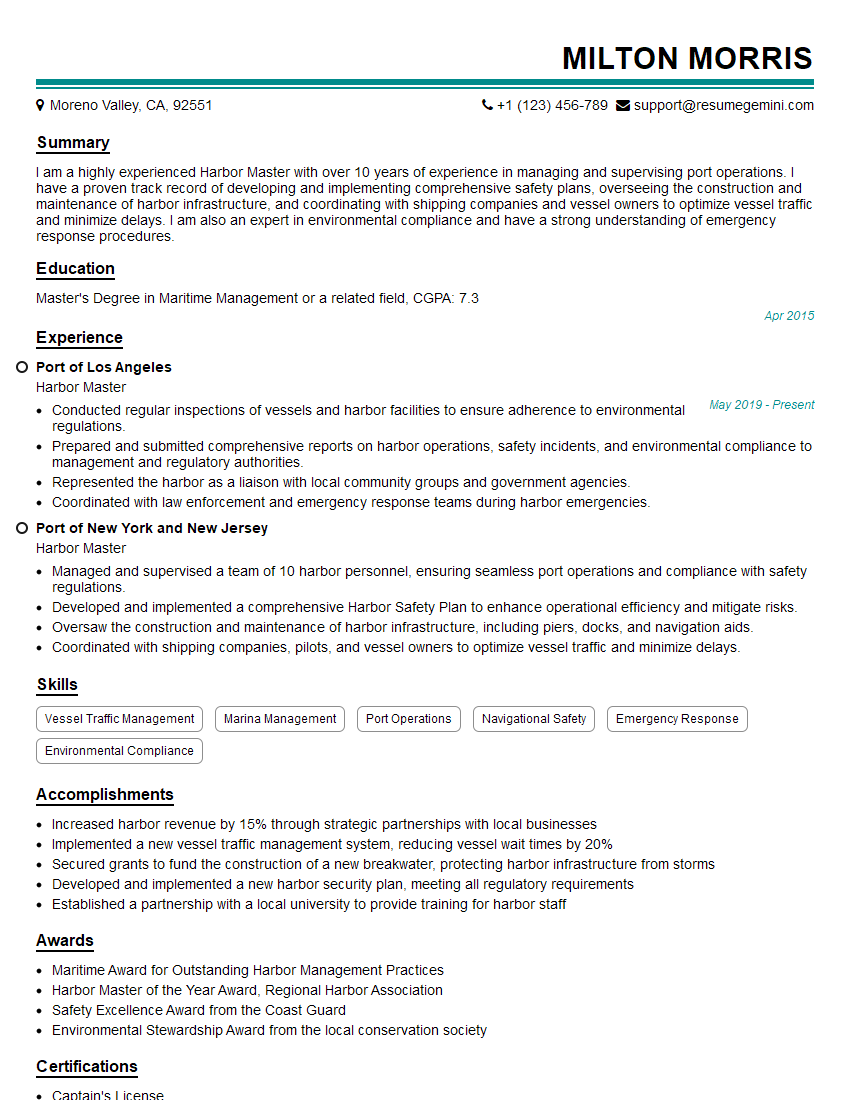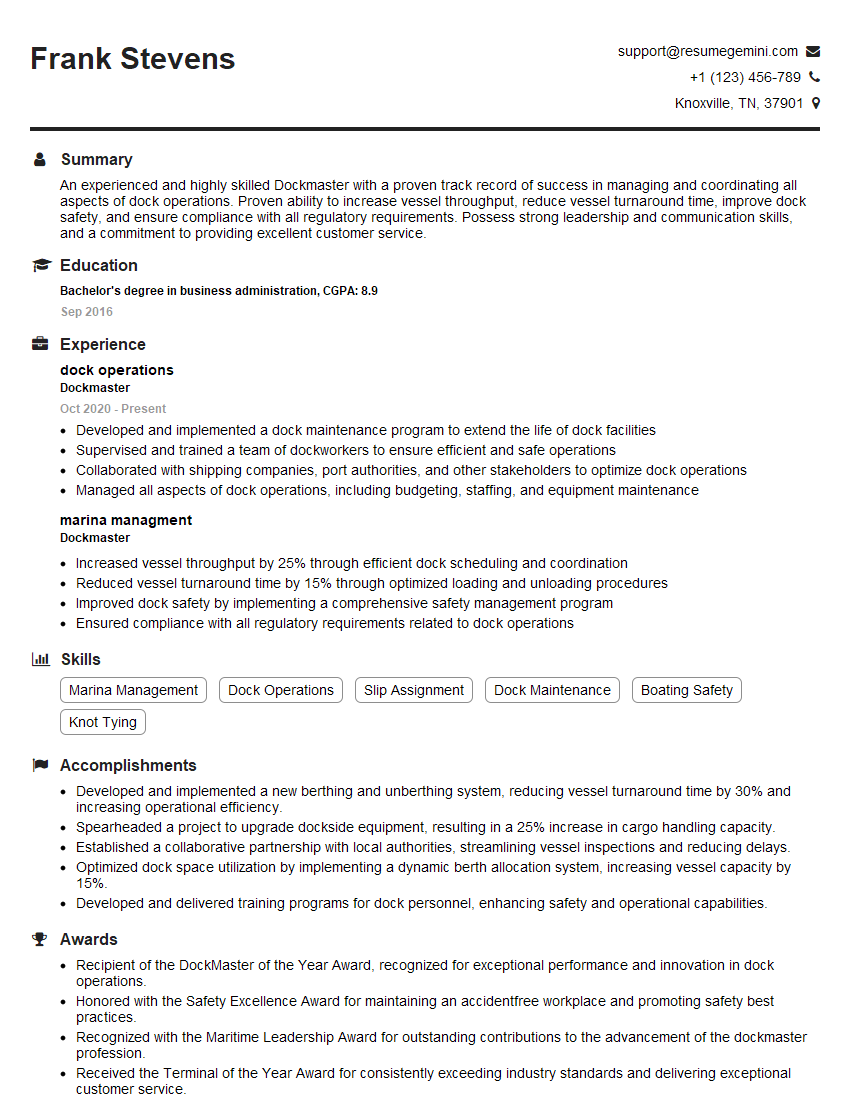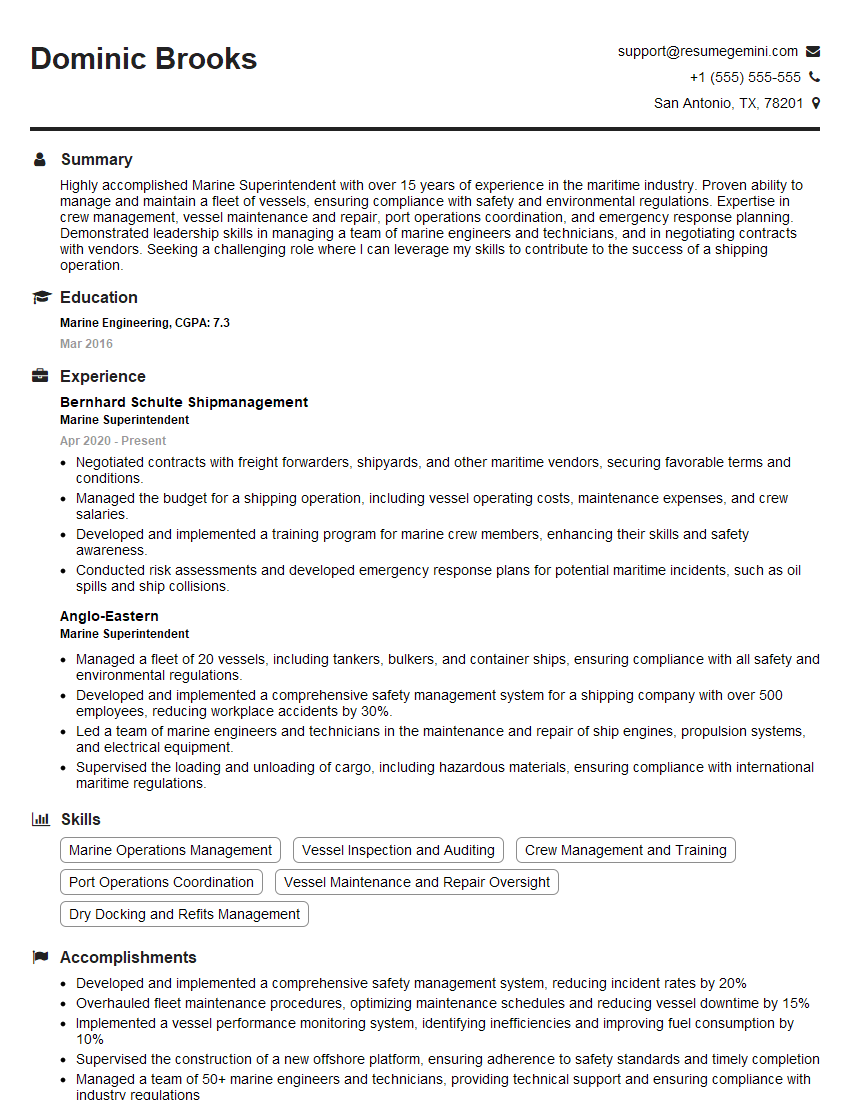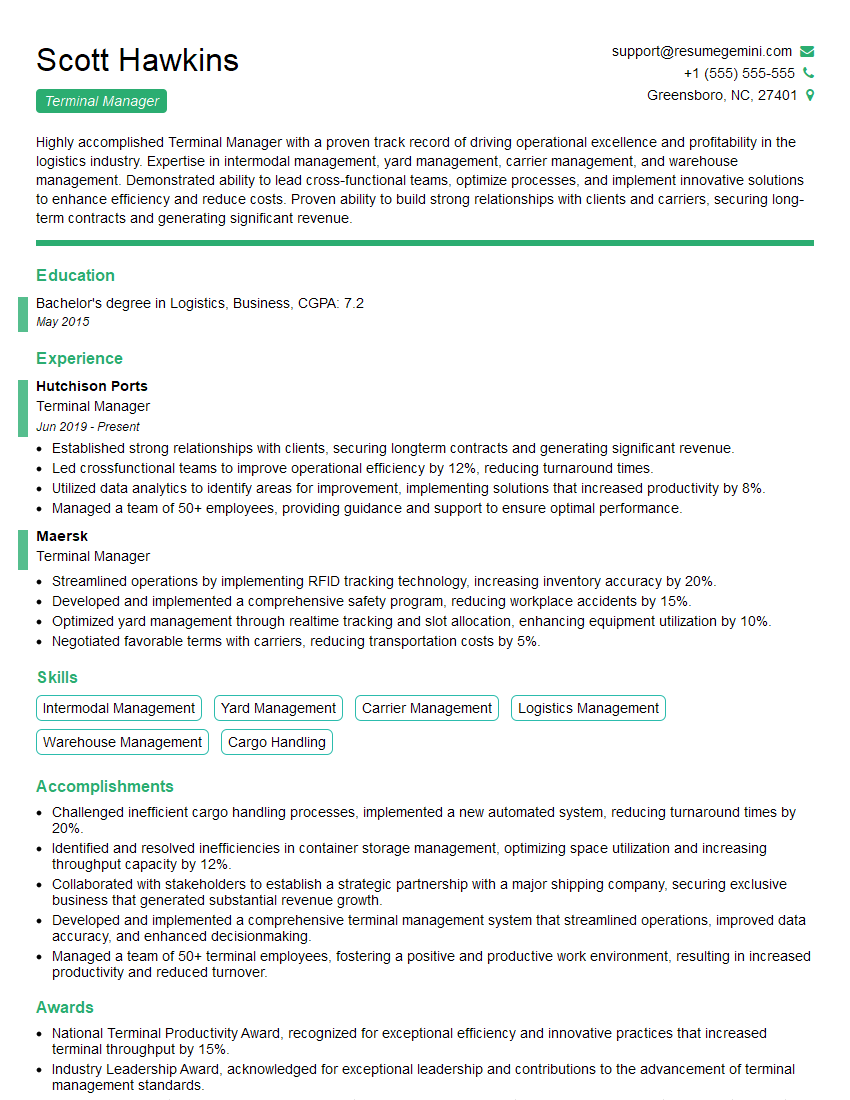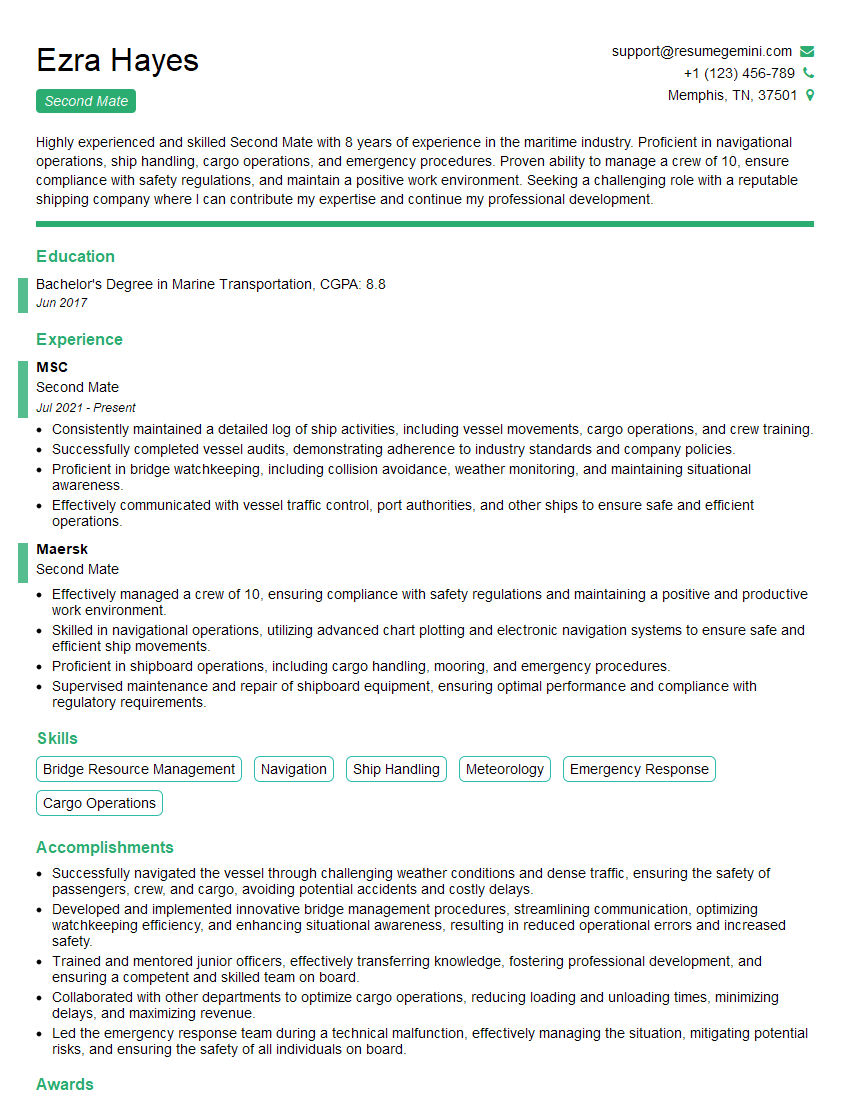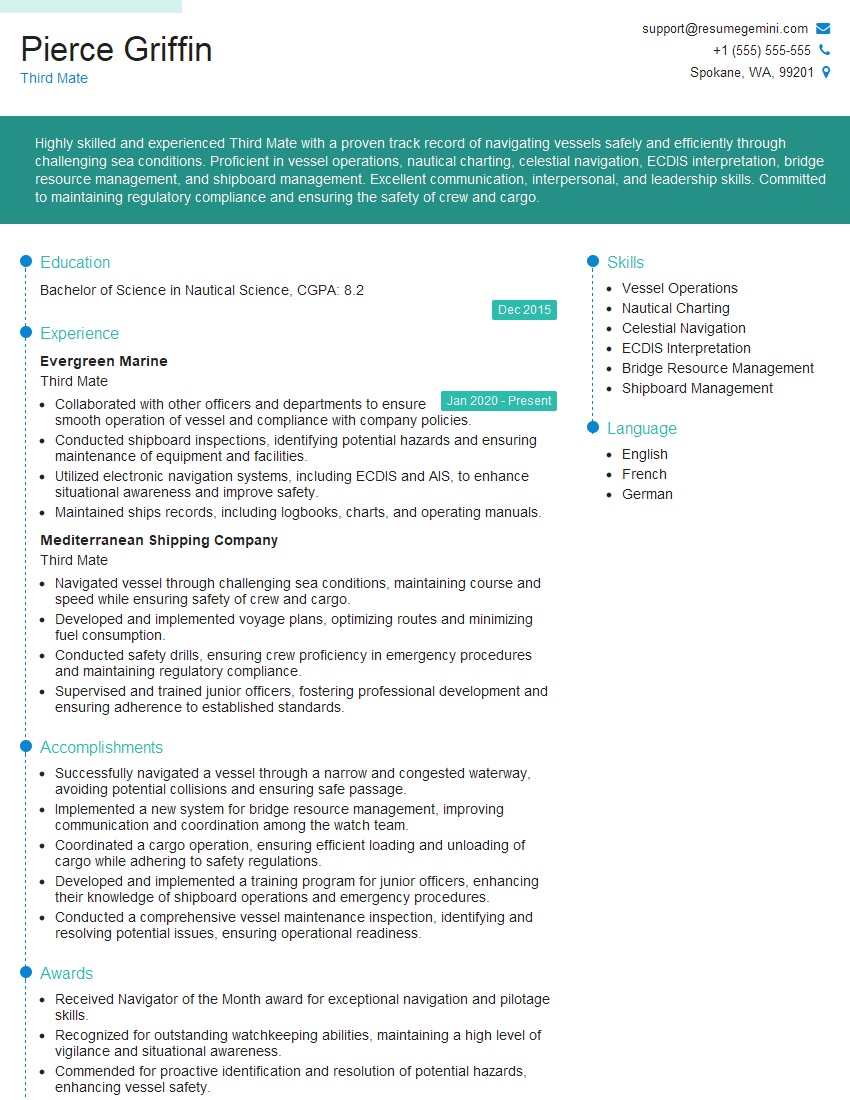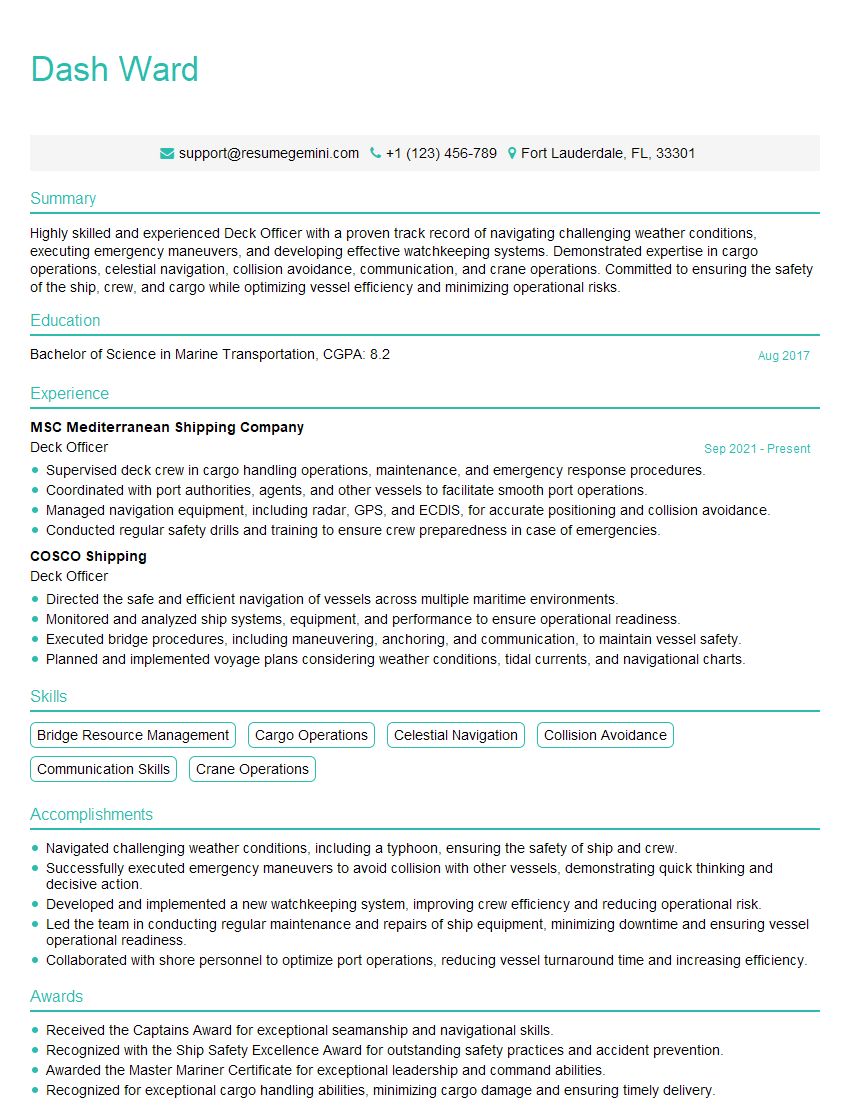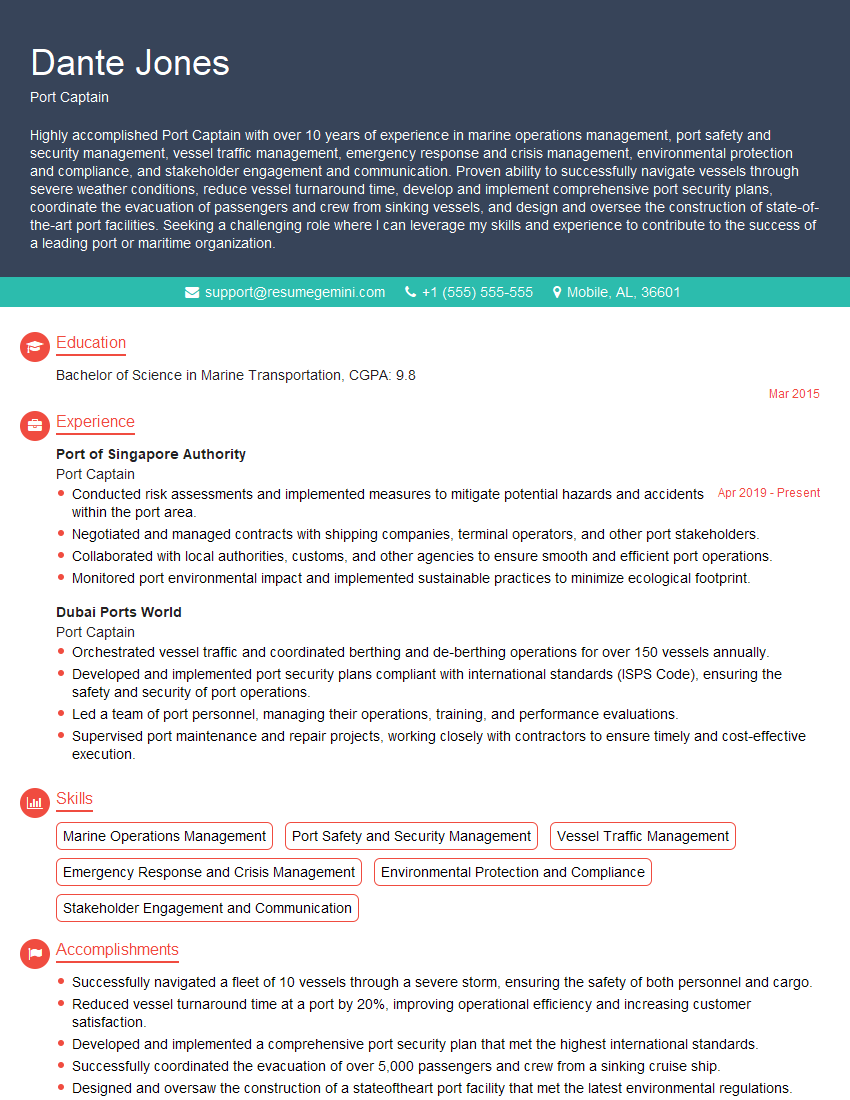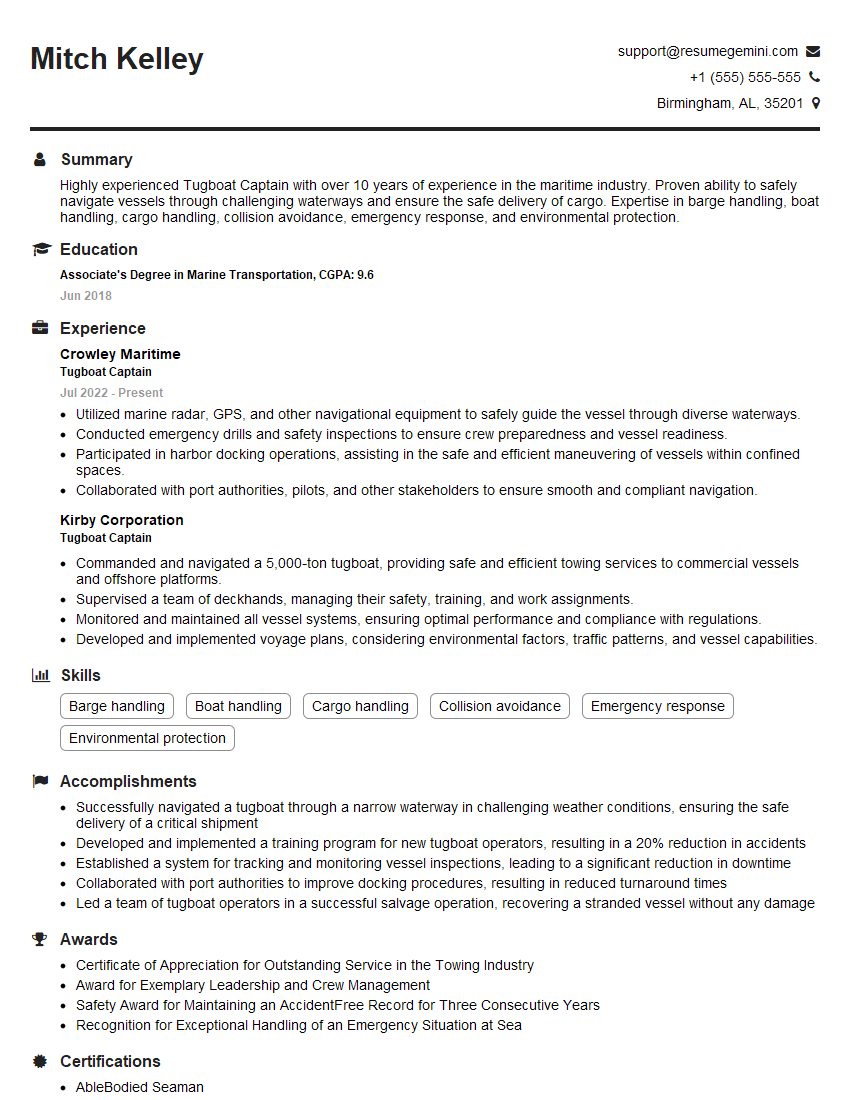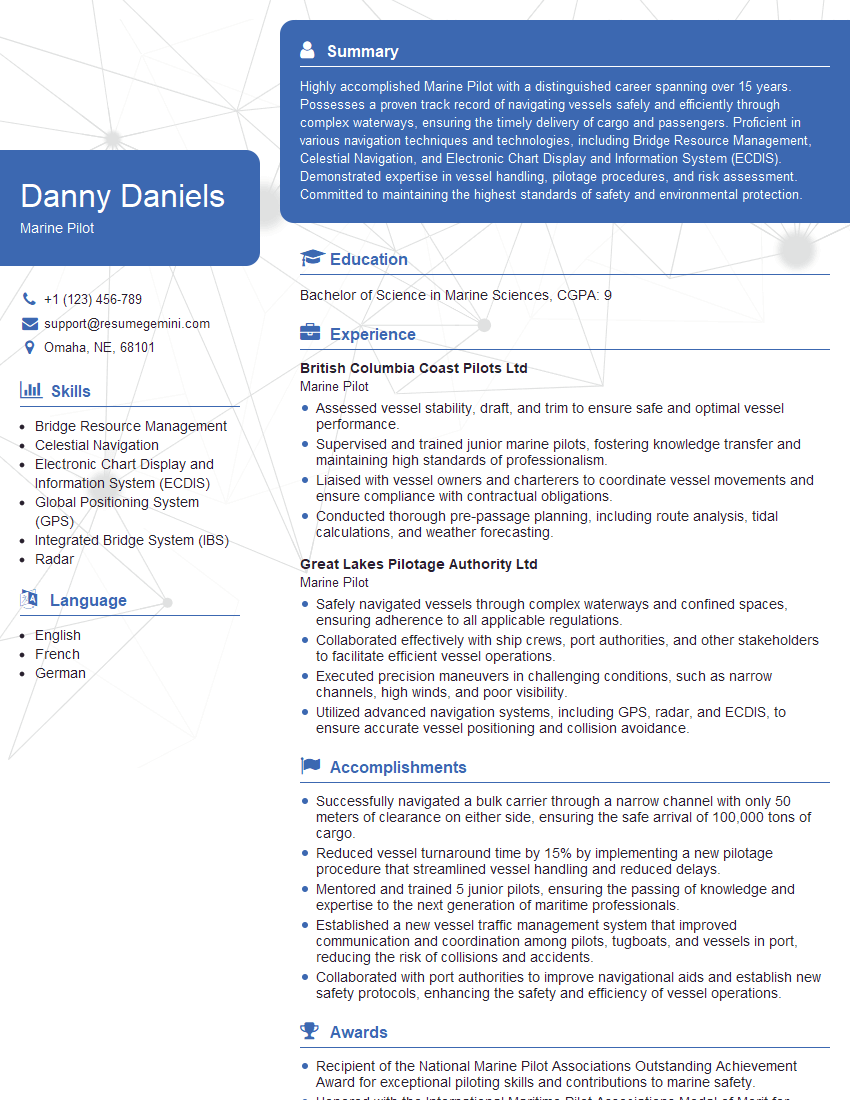Unlock your full potential by mastering the most common Berthing and Unberthing interview questions. This blog offers a deep dive into the critical topics, ensuring you’re not only prepared to answer but to excel. With these insights, you’ll approach your interview with clarity and confidence.
Questions Asked in Berthing and Unberthing Interview
Q 1. Explain the process of calculating safe berthing distances.
Calculating safe berthing distances involves considering several factors to prevent collisions and damage. It’s not a single formula but a process of risk assessment. We start by determining the vessel’s dimensions (length, beam, draft) and maneuvering characteristics (turning radius, speed).
Next, we assess the berth’s characteristics: its length, depth, and the presence of any obstructions (e.g., dolphins, other vessels). Environmental conditions like wind speed, current, and tide play a crucial role. Strong winds can push a vessel off course, while currents and tides affect the vessel’s approach speed and position.
Finally, we factor in the experience and skill of the crew, the type of berthing equipment available (e.g., tugs, mooring lines), and the vessel’s control systems. A larger safety margin is always applied in challenging conditions. A common approach involves using nautical charts and harbormaster guidelines to determine safe clearance distances, then adding buffer zones based on the specific risk assessment. For example, in strong winds, we’d significantly increase the distance to account for potential wind drift.
Q 2. Describe different berthing methods and their suitability for various vessel types.
Several berthing methods exist, each suited to different vessel types and berth conditions.
- Alongside berthing: The vessel comes alongside a quay or another vessel. This is common for most vessel types and is relatively straightforward in calm conditions. However, it requires precise maneuvering and careful control of speed and heading.
- Stern-to berthing: The vessel’s stern is secured to the berth, with the bow facing outward. This method is often used for vessels that need quick access for loading and unloading operations. It’s more challenging than alongside berthing and demands more experienced crew.
- Head-to berthing: The vessel’s bow is secured to the berth. This is often used in sheltered areas or for smaller vessels. Similar to stern-to, this approach needs precise control and more expertise.
- Med mooring: Used for larger vessels, this involves anchoring the vessel’s stern and using mooring lines to control its position. This method helps to minimize hull damage and strain on mooring lines.
The choice of berthing method depends heavily on the vessel’s size, maneuverability, the berth’s configuration, and prevailing weather conditions. A large tanker will require a different approach than a smaller tug boat, for instance.
Q 3. How do you assess the suitability of a mooring arrangement for a given vessel and weather conditions?
Assessing mooring arrangement suitability involves a thorough evaluation of several key factors. First, we consider the vessel’s size and weight distribution. This dictates the required strength of the mooring lines and the number of mooring points. The type of vessel also influences this; a container ship’s distribution is different than a bulk carrier.
Next, we examine the berth’s characteristics—its structural integrity, the strength of the bollards, and the available space for mooring lines. The depth and bottom conditions at the berth are equally critical. Shallow water or unstable seabed can compromise the effectiveness of moorings. We also examine the prevailing weather forecast, including wind speed, wave height, and current. Strong winds or currents will require a stronger and more robust mooring arrangement.
Finally, we analyze the type and condition of the mooring equipment – are the lines strong enough, the fenders adequate, the bollards secure? A comprehensive risk assessment, incorporating all these factors, determines the suitability of a specific mooring arrangement for a given vessel and weather conditions.
For example, if a strong storm is approaching, a vessel might require additional lines, stronger anchors or even a change of berth altogether.
Q 4. What are the common risks associated with berthing and unberthing operations?
Berthing and unberthing operations present several risks.
- Collision damage: Damage to the vessel, the berth, or other vessels during berthing/unberthing maneuvers.
- Personnel injury: Risk of injury to crew members due to falling objects, crushing, or entanglement in lines.
- Equipment failure: Failure of mooring lines, fenders, or other equipment can lead to loss of control of the vessel.
- Environmental damage: Potential damage to the marine environment from spills or grounding.
- Cargo damage: Improper handling can cause damage to cargo during loading/unloading.
- Grounding: Running aground, typically caused by improper planning or adverse conditions.
The severity of these risks varies depending on the vessel type, berth conditions, and prevailing weather conditions.
Q 5. Outline your approach to risk mitigation during berthing and unberthing procedures.
Risk mitigation is paramount. Our approach starts with a thorough pre-berthing/unberthing plan, including a risk assessment that identifies potential hazards and outlines preventive measures. This plan involves detailed communication with the harbor master and other involved parties, such as tug operators.
We ensure all crew members are adequately trained and competent in their assigned tasks. Appropriate safety equipment (e.g., life jackets, safety harnesses) must be readily available and in good working order. Regular equipment inspections and maintenance are critical to prevent failures.
We use redundant systems where possible; for instance, multiple mooring lines are deployed to increase safety. Adequate fendering protects the vessel and berth structures from damage. We also have contingency plans in place for unexpected situations, such as strong winds or equipment failure. Regular drills help train the crew to deal with such scenarios effectively. This layered approach greatly improves safety and minimizes risk.
Q 6. How do you handle unexpected situations, such as strong winds or equipment failure, during berthing?
Handling unexpected situations requires a calm and decisive response. If strong winds suddenly develop during berthing, the immediate action is to slow the vessel down and use the available tugs and mooring lines to maintain control and prevent the vessel from drifting. We prioritize safety by stopping the operation if the conditions become too hazardous.
In case of equipment failure (e.g., a mooring line snapping), we immediately assess the situation, securing the vessel with the remaining lines. Contingency plans, developed during the risk assessment phase, determine the best course of action, which might involve using spare lines, requesting additional tugs, or even requesting a change of berth if conditions worsen.
Clear communication between the bridge, deck crew, and harbor control is crucial in such emergencies. A well-rehearsed emergency response plan ensures an effective and coordinated response to these unforeseen events.
Q 7. Describe your experience with using various mooring equipment (e.g., ropes, fenders, anchors).
My experience with mooring equipment encompasses a wide range of vessel types and operating environments. I’m proficient in selecting and using appropriate mooring lines (wire, synthetic fiber) based on their strength, elasticity, and suitability for specific tasks. I understand the importance of proper line handling techniques to prevent chafing and breakage.
I have extensive experience using various types of fenders (rubber, foam, cylindrical) to protect vessel hulls and quay walls during berthing. My experience also covers different anchoring systems, including selecting appropriate anchors for various seabed conditions and deploying them effectively. This includes understanding anchor holding power calculations, setting and recovering anchors safely and the importance of checking for proper anchor setting.
I’m familiar with various mooring equipment inspection and maintenance procedures and always ensure all equipment is regularly checked for damage and wear before every operation. This proactive approach to equipment maintenance is essential for safety and operational efficiency.
Q 8. What are the key communication protocols during berthing and unberthing operations?
Effective communication is paramount during berthing and unberthing. We rely on a multi-layered approach, combining visual signals, verbal communication, and sometimes even dedicated communication systems.
- Visual Signals: Hand signals, standardized internationally, are crucial for short-range communication between the vessel and the dockside crew. These signals direct tugboat movements, line handling, and overall maneuvering.
- Verbal Communication: VHF radio is the primary means of long-range communication. Clear, concise instructions are relayed between the vessel’s bridge, the harbormaster, tugboat captains, and shore-based personnel. We use established terminology to avoid confusion, such as reporting wind speed, current direction, and vessel position.
- Dedicated Communication Systems: Larger ports might employ sophisticated systems allowing real-time data sharing, like vessel location and speed. This facilitates better coordination, particularly in congested areas.
For example, during a challenging berthing in strong winds, clear radio communication between the captain, tugboat captain, and shore crew is vital to adjust the approach angle and speed, ensuring a safe docking.
Q 9. Explain the role of the tugboats in berthing and unberthing large vessels.
Tugboats are indispensable for berthing and unberthing large vessels, particularly in confined spaces or challenging conditions. Their powerful engines and maneuverability provide crucial assistance.
- Maneuvering Assistance: Tugboats help control the vessel’s speed and direction, ensuring precise alignment with the berth. This is especially critical with large tankers or container ships which have limited maneuverability.
- Emergency Response: Should the vessel lose propulsion or encounter unexpected strong currents or winds, tugboats provide immediate support to prevent collisions or damage.
- Line Handling: Tugboats assist in the handling of mooring lines, ensuring they’re correctly secured to the bollards and fenders on the dock.
Imagine attempting to berth a massive container ship in a busy port without tugboat assistance – it would be incredibly difficult, if not impossible, to achieve a safe and controlled berthing.
Q 10. How do you ensure the safety of crew members during berthing and unberthing?
Crew safety is the highest priority. We employ a range of measures to minimize risks during these potentially hazardous operations.
- Risk Assessments: Before each operation, a thorough risk assessment is conducted, considering weather conditions, vessel type, berth characteristics, and crew experience. Specific safety precautions are implemented based on this assessment.
- Personal Protective Equipment (PPE): All crew members wear appropriate PPE, including safety helmets, high-visibility clothing, and safety footwear. Life jackets are readily available and often mandatory.
- Designated Work Areas: Clear zones are established around the mooring lines and active machinery. Crew members are instructed to stay within these designated areas to avoid getting entangled or injured.
- Emergency Procedures: Emergency procedures are clearly defined and regularly practiced. This includes procedures for dealing with line failures, equipment malfunction, and medical emergencies.
For instance, before commencing berthing in rough seas, we’ll ensure all crew are wearing life jackets and that the appropriate safety equipment is readily available near the work areas. We also enforce strict communication protocols to prevent accidents.
Q 11. What are the regulations and standards that govern berthing and unberthing operations?
Berthing and unberthing operations are governed by a comprehensive set of regulations and standards, which vary depending on location and governing bodies.
- International Maritime Organization (IMO): The IMO sets international standards for ship safety and operational practices. Many of these standards directly influence berthing and unberthing procedures.
- Port State Control: Authorities in each port enforce local regulations and conduct inspections to ensure compliance with international and national maritime laws.
- National and Local Regulations: Each country or port will have its own specific regulations related to pilotage, tugboat requirements, communication protocols, and environmental protection.
- Company-Specific Standards: Shipping companies typically have their internal safety procedures that exceed the minimum legal requirements, ensuring a consistent and high safety level across their operations.
Compliance with these regulations is critical to ensure safe and efficient operations and avoid penalties and legal repercussions.
Q 12. Describe your experience with different types of berthing aids (e.g., dolphins, bollards).
My experience encompasses a wide range of berthing aids. Each type offers unique advantages and requires specific handling techniques.
- Dolphins: These are sturdy, independent structures used for mooring lines, particularly in exposed locations. They provide a strong point of attachment and are designed to absorb the impact of vessels. I’ve worked extensively with dolphins in exposed harbors where they provide excellent protection from harsh weather.
- Bollards: These are fixed posts on the quayside used for securing mooring lines. Different types of bollards are used, depending on the expected load. The correct choice of bollard, ensuring a snug fit and proper line handling, is essential for preventing line slippage and damage.
- Fenders: Fenders, whether made of rubber, polyurethane, or other materials, protect both the vessel and the quayside structure from damage during berthing and unberthing. Their proper placement and condition are key to prevent costly damage.
Each berthing operation requires careful consideration of the available aids to ensure a smooth and secure operation. The wrong choice or improper use can lead to accidents.
Q 13. How do you determine the appropriate speed and angle of approach during berthing?
Determining the appropriate speed and angle of approach is a crucial aspect of safe berthing. Several factors influence this decision.
- Wind and Current: Strong winds or currents necessitate a slower approach speed and adjustments to the angle to compensate for their influence on the vessel’s movement.
- Vessel Size and Maneuverability: Larger vessels require more space and a gentler approach compared to smaller ones. The vessel’s propulsion system and responsiveness also play a vital role.
- Berth Configuration: The characteristics of the berth, including its size, shape, and the arrangement of fenders and bollards, will impact the ideal approach angle.
- Experience and Judgement: The captain and the docking pilot will use their judgment and experience to make adjustments based on real-time conditions.
A common mistake is approaching too fast or at an incorrect angle, which can lead to a difficult or even unsafe berthing. The pilot will often slow the ship far from the dock to plan a safe approach and maintain steady control.
Q 14. What are the signs of potential mooring line failure, and how do you address them?
Recognizing the signs of potential mooring line failure is crucial for preventing accidents. Careful observation and regular inspection are paramount.
- Unusual Wear and Tear: Excessive chafing, fraying, or cuts on the lines indicate potential weakness and imminent failure. We use UV protection to extend the line’s life and reduce chafing.
- Over-Tightening: Lines stretched too tightly can snap under stress. We use proper tensioning techniques and equipment.
- Unusual Sounds or Vibrations: A line rubbing against a structure or vibrating excessively often points to a problem that needs immediate attention. We regularly listen to the lines.
- Changes in Line Angle: A sudden or unusual change in the angle of a mooring line could indicate a problem with the line or its securing point.
If any of these signs are observed, we take immediate action. This might involve replacing the line, re-securing it, or reducing the load on the line. In some cases, we might need to use additional lines to redistribute the load or even use the tugboats to help relieve the strain on a damaged line before replacing it.
Q 15. How do you manage the interaction between the vessel and the dock during berthing and unberthing?
Managing the interaction between vessel and dock during berthing and unberthing is crucial for safe and efficient operations. It involves a delicate balance of controlling the vessel’s momentum, using fenders to absorb impact, and precise maneuvering with the aid of tugboats and mooring lines. Think of it like a carefully choreographed dance where the vessel is one partner and the dock the other. Each needs to move with precision to avoid collision.
This involves constant monitoring of vessel speed, heading, and distance from the dock using various navigation tools such as radar, GPS, and the ship’s own maneuvering systems. We use slow and controlled movements, adjusting speed and direction based on real-time feedback from the bridge team and shore personnel. Fenders are strategically placed to protect the hull and dock from damage during contact. Finally, mooring lines are secured methodically to firmly hold the vessel against the dock.
For example, when berthing a large container ship in strong winds, we might use tugboats to assist with maintaining the vessel’s position, slowing its approach, and preventing it from swinging uncontrollably against the dock. The careful use of fenders and the coordinated efforts of multiple crew members and tugboat captains are critical for a successful berthing.
Career Expert Tips:
- Ace those interviews! Prepare effectively by reviewing the Top 50 Most Common Interview Questions on ResumeGemini.
- Navigate your job search with confidence! Explore a wide range of Career Tips on ResumeGemini. Learn about common challenges and recommendations to overcome them.
- Craft the perfect resume! Master the Art of Resume Writing with ResumeGemini’s guide. Showcase your unique qualifications and achievements effectively.
- Don’t miss out on holiday savings! Build your dream resume with ResumeGemini’s ATS optimized templates.
Q 16. Explain your understanding of tidal effects on berthing and unberthing.
Tidal effects significantly influence berthing and unberthing operations, impacting water depth, vessel draft (how deep the vessel sits in the water), and the available maneuvering space. Understanding and accounting for these changes are fundamental to safe port operations. Imagine trying to park a car on a ramp that’s constantly rising or falling; the same principles apply here, but on a much larger scale.
High tide provides more water depth, allowing larger vessels to berth safely, but also potentially increases the speed of currents, which need to be factored into the maneuvering strategy. Conversely, low tide reduces water depth, limiting the draft of vessels that can berth safely and potentially causing grounding issues or making maneuvering difficult due to reduced clearance under the hull. We carefully consult tide tables and predictions to plan berthing/unberthing times to optimize water depth and current conditions.
For instance, a vessel might be scheduled to berth during high tide to ensure sufficient water depth to avoid grounding, and the unberthing might be planned for a period when currents are favorable to allow efficient vessel departure.
Q 17. How do you coordinate with shore-based personnel during berthing and unberthing operations?
Coordination with shore-based personnel, including port control, terminal operators, and tugboat captains, is paramount for successful berthing and unberthing operations. Clear communication channels, such as VHF radio and dedicated communication systems, are used for continuous information exchange. We employ a collaborative approach, keeping everyone informed of the vessel’s progress and any potential challenges.
Before beginning the operation, we exchange critical information such as the vessel’s details, arrival time, planned berthing location, and any operational constraints. During the process, we share real-time updates on position, speed, and any observed anomalies with shore-based personnel, ensuring everyone is aware of the vessel’s progress and can offer assistance or adjust plans if needed. This constant communication ensures that all actions are coordinated efficiently and safely, creating a synchronized effort to avoid conflicts and delays.
A typical example would be coordinating with tugboat captains to determine the optimal number and positioning of tugs during a challenging berthing in strong winds. We also coordinate with terminal operators to ensure that sufficient linesmen are available to secure the vessel’s mooring lines once berthed.
Q 18. Describe your experience with using different types of fenders.
My experience encompasses a wide range of fender types, each designed for specific applications and conditions. The selection depends on the vessel size, dock structure, anticipated impact forces, and the environmental conditions. Choosing the right fender is like selecting the right protective gear for a specific sport – the wrong choice can lead to serious consequences.
I’ve worked with various types including cylindrical rubber fenders (common for their versatility), celluar rubber fenders (offering high energy absorption), and Yokohama fenders (excellent for very high impact forces). Each has its own advantages and disadvantages in terms of energy absorption, durability, and cost-effectiveness. We carefully assess the situation and select fenders that provide adequate protection while considering factors such as space constraints and the vessel’s structural design.
For example, a larger vessel berthing alongside a concrete quay might require robust Yokohama fenders to handle the significant impact forces. In contrast, a smaller vessel docking at a lighter structure might be adequately protected using more compact cylindrical rubber fenders. The placement of the fenders is equally critical, ensuring they absorb the impact energy effectively.
Q 19. How do you ensure the vessel remains secure during periods of inclement weather?
Securing the vessel during inclement weather requires proactive measures and constant vigilance. The primary goal is to prevent the vessel from breaking free from its moorings and potentially causing damage or injury. This involves assessing the weather forecast and adjusting our strategies accordingly. Think of it as preparing a house for a hurricane – taking steps to reinforce its structural integrity.
This includes using additional mooring lines to enhance security, utilizing extra fenders for increased protection, and potentially engaging additional tugboats for assistance in holding the vessel in place. We constantly monitor weather conditions and adjust our strategy as needed, potentially implementing additional measures like deploying additional anchors in extreme circumstances. Regular inspections of the mooring lines and fenders are vital to detect any damage or weakening.
In a real-world scenario, during a storm surge, we might add extra mooring lines to the vessel and increase the number of tugboats to provide extra holding power. We would closely monitor the tension in each line and adjust as needed to prevent excessive strain on the vessel’s structure or the dock infrastructure.
Q 20. What are the environmental considerations when berthing and unberthing a vessel?
Environmental considerations are paramount during berthing and unberthing. We strive to minimize the impact of our operations on the marine ecosystem. This includes preventing pollution, protecting marine life, and reducing noise and air emissions. It’s about being responsible stewards of our environment. Our aim is to operate in an environmentally friendly manner, limiting the footprint of our activities.
This requires careful planning to avoid accidental oil spills, implementing measures to minimize noise pollution, and selecting environmentally friendly fender systems. The use of ballast water management systems to prevent the spread of invasive species is another crucial environmental consideration. We also ensure that all waste disposal procedures are followed correctly to prevent pollution of the waters.
For example, we would ensure that appropriate spill response equipment is readily available and regularly inspected in case of an oil spill. Furthermore, our choice of fenders would consider their environmental impact – favoring biodegradable options where appropriate. We also strictly adhere to noise regulations, ensuring that our operations do not unduly disturb marine wildlife.
Q 21. Describe your experience with emergency procedures related to berthing and unberthing.
Emergency procedures during berthing and unberthing are crucial for immediate and effective response to unforeseen situations. These procedures are regularly practiced and thoroughly understood by all involved personnel. We utilize a structured approach, prioritizing safety and minimizing potential damage or harm. It’s about being prepared for anything that might go wrong.
This includes clear communication channels, immediate actions to secure the vessel if it breaks free, and procedures for handling emergencies such as fires, collisions, or personnel injuries. We have established contingency plans for various scenarios, including the availability of emergency response teams and equipment. Regular drills and training ensure the team is well-prepared to respond effectively to any unexpected event.
For instance, if a mooring line snaps during berthing, we have pre-defined procedures to immediately engage a replacement line, possibly using a tug to hold the vessel steady while the repair takes place. In the event of a collision, our response would include activating emergency services, assessing the extent of damage, and initiating procedures to minimize further risk and injury. Detailed reporting and investigation follow all incidents to learn from experiences and improve future safety protocols.
Q 22. How do you utilize navigational aids (e.g., GPS, radar) during berthing and unberthing?
Navigational aids are crucial for safe and efficient berthing and unberthing. GPS provides precise position information, allowing me to accurately track the vessel’s movement and maintain the desired heading and speed. Radar provides a real-time picture of the surrounding environment, including other vessels, buoys, and landmasses, helping me anticipate potential hazards and adjust the vessel’s course accordingly. For instance, during a tight berthing maneuver in a crowded port, I would rely heavily on radar to monitor the position of neighboring vessels and ensure sufficient clearance. I also utilize the Automatic Identification System (AIS) to track the movements of other ships equipped with AIS transponders, further enhancing situational awareness.
In addition, Electronic Chart Display and Information Systems (ECDIS) integrate data from various sources like GPS, radar, and charts to give a comprehensive view of the situation, allowing for more precise maneuvering. For example, using ECDIS’s route planning features, I can pre-plan the berthing approach, including predicted vessel positions and potential conflict areas, improving efficiency and safety.
Q 23. What is your approach to pre-berthing planning and risk assessment?
Pre-berthing planning is paramount. It begins with a thorough review of the port’s navigational charts, considering water depths, currents, tides, wind conditions, and the berth’s layout. I assess potential hazards like obstructions, restricted areas, or nearby vessels. This involves checking the vessel’s particulars, such as draft, length, and maneuverability, to ensure compatibility with the designated berth.
Risk assessment is an iterative process. I identify potential hazards during berthing, such as collision with quay walls, other vessels, or infrastructure; line handling failures; or equipment malfunctions. I develop mitigation strategies for each hazard, which could include adjusting speed and heading, deploying extra fenders, or having standby tugs.
A detailed plan, including communication protocols, tugboat deployment, and line handling procedures, is created and reviewed with the bridge team and port authorities. For example, if strong winds are predicted, I may request additional tug support or adjust the approach angle to minimize wind effects.
Q 24. Explain your understanding of vessel stability and its impact on berthing and unberthing.
Vessel stability is critically important during berthing and unberthing. An unstable vessel is more prone to excessive movement, increasing the risk of collision and damage. Factors influencing stability include the vessel’s loading condition (cargo distribution), the presence of free surfaces (liquids in tanks), and the environmental conditions (wind and waves).
Before starting the berthing process, I ensure the vessel’s stability is within acceptable limits. This might involve checking the stability data provided by the cargo officer or reviewing the vessel’s stability booklet. I also take environmental factors into account. For instance, high winds or heavy seas can compromise stability, requiring extra caution or delaying operations if necessary. Understanding the vessel’s dynamic characteristics, such as its response to helm commands and thruster inputs, is essential for precise maneuvering while maintaining stability.
Maintaining sufficient trim (difference in draft between the bow and stern) is also important for effective control. If the vessel is too stern-heavy, for example, it may be difficult to manage the stern during berthing, increasing the risk of collision. A well-trimmed vessel simplifies the berthing procedure.
Q 25. How do you manage communication with the bridge and tugboat operators during berthing and unberthing?
Clear and concise communication is vital. I utilize a variety of methods, including VHF radio, hand signals, and dedicated communication systems. With the bridge team, I coordinate the vessel’s movements, reporting speed, heading, and any significant changes in the situation. Pre-established communication protocols with specific terminology ensure that everyone understands the instructions clearly and unambiguously. For example, I might use phrases like ‘Stand by to heave lines,’ ‘Slow ahead,’ or ‘Emergency stop’ to convey instructions swiftly.
Communication with tugboat operators is equally important. I coordinate their movements to ensure they assist in a safe and efficient manner. I establish clear hand signals before starting the maneuver to assist in close-quarters communication. Effective communication prevents misunderstandings that could compromise safety during the berthing or unberthing process. During an emergency, clear and concise instructions are essential to ensure effective and coordinated response.
Q 26. Describe your experience with various types of vessel (e.g., tankers, container ships, bulk carriers).
My experience encompasses a wide range of vessels, including tankers, container ships, and bulk carriers. Each vessel type presents unique challenges. Tankers, for instance, require careful consideration of their large size, limited maneuverability, and the potential hazards associated with their cargo. Container ships, with their high freeboard and often complex mooring arrangements, require precise maneuvering to avoid damage to the containers and the vessel.
Bulk carriers present a different set of concerns, their cargo influencing stability and making precise trimming adjustments crucial. My experience enables me to adapt my approach to the specific characteristics of each vessel type, ensuring the safety and efficiency of the berthing and unberthing operations. The knowledge acquired from years of experience handling different vessel types improves my ability to adapt and handle any unforeseen challenges during the operations.
Q 27. How do you assess the condition of mooring lines before and after berthing and unberthing operations?
Before berthing, I visually inspect all mooring lines for wear and tear, ensuring they are free of knots, chafe, and other defects. I check their strength and diameter to ensure they are suitable for the expected load. I verify that all fittings are correctly attached and secure. This proactive approach minimizes the risk of line failure during berthing.
After berthing and before unberthing, I assess the condition of the lines again, checking for signs of damage or wear caused by friction against the quay wall, bollards, or other vessels. Any damaged lines are reported and replaced. This ensures the continued safety and security of the vessel. Proper maintenance and regular inspection of mooring lines are vital to prevent accidents caused by line failures during berthing or unberthing operations.
Key Topics to Learn for Berthing and Unberthing Interview
- Vessel Handling Fundamentals: Understanding vessel characteristics, maneuvering limitations, and the impact of environmental factors (wind, current, tide) on berthing/unberthing operations.
- Mooring Systems and Equipment: Familiarity with different types of mooring lines, winches, and their operation; understanding line tension, handling techniques, and safety procedures.
- Berthing/Unberthing Procedures: Detailed knowledge of standard operating procedures, including pre-berthing/unberthing checks, communication protocols, and emergency response plans.
- Navigation and Piloting: Applying navigation skills to accurately position the vessel during berthing and unberthing; understanding the use of navigational aids and electronic charting systems.
- Risk Assessment and Safety: Identifying potential hazards associated with berthing/unberthing operations and implementing appropriate safety measures; understanding the importance of teamwork and communication in mitigating risks.
- Communication and Teamwork: Effective communication with bridge personnel, tug masters, harbor masters, and other stakeholders involved in berthing/unberthing operations.
- Practical Application: Ability to describe real-world scenarios, including challenging berthing/unberthing situations, and how you would address them, considering various constraints (e.g., space limitations, weather conditions).
- Problem-Solving and Decision-Making: Demonstrating the ability to analyze situations quickly, make informed decisions under pressure, and adapt to unexpected circumstances during berthing/unberthing.
- Legal and Regulatory Compliance: Understanding relevant maritime regulations and safety standards related to berthing and unberthing operations.
Next Steps
Mastering berthing and unberthing techniques is crucial for career advancement within the maritime industry, opening doors to greater responsibility and higher earning potential. To significantly enhance your job prospects, creating a strong, ATS-friendly resume is essential. ResumeGemini is a trusted resource that can help you build a professional and impactful resume tailored to highlight your skills and experience in berthing and unberthing. We provide examples of resumes specifically designed for this field to help guide you. Invest time in crafting a compelling resume – it’s your first impression on potential employers.
Explore more articles
Users Rating of Our Blogs
Share Your Experience
We value your feedback! Please rate our content and share your thoughts (optional).
What Readers Say About Our Blog
Hi, I’m Jay, we have a few potential clients that are interested in your services, thought you might be a good fit. I’d love to talk about the details, when do you have time to talk?
Best,
Jay
Founder | CEO
